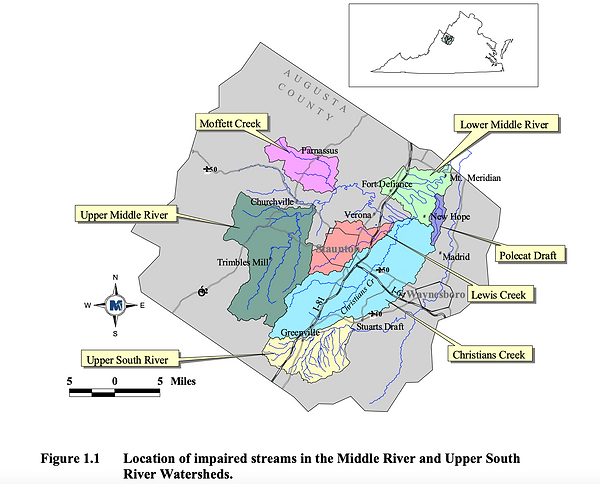Middle River's Role in the Chesapeake Bay
by Robert “Bobby” Whitescarver
The Middle River is part of the Chesapeake Bay watershed. This means that the water in our river eventually reaches the largest estuary in North America. What we do here, on all the land that drains into the Middle River not only affects our River, but it affects the Chesapeake Bay as well.
What’s a TMDL?
TMDL stands for Total Maximum Daily Load. It’s the calculation of the maximum amount of a pollutant that can be in a waterbody and still meet water quality standards. As per the Clean Water Act--a U.S. federal law passed in 1972 that regulates the discharge of pollutants into the nation's surface waters-- Virginia has set water quality standards for streams, rivers, lakes, and the Bay. Most of Middle River and its tributaries exceed the state standards for certain pollutants and so does the Bay. Once a water body exceeds the maximum daily load for a pollutant it is deemed “impaired” and is placed on the state’s Impaired Waters List. Many call this the “dirty waters list.” Much of Middle River, but not all, is considered “impaired.”
The Middle River TMDL
The Middle River and all of its tributaries such as Moffett Creek, Lewis Creek, Christians Creek, and Back Creek exceed the state standards for bacteria, aquatic life, or both and other standards such as toxins.

Once a water body is placed on the impaired waters list, the Virginia Department of Environmental Quality develops a TMDL for the pollutant and a plan with a scheduled end date to reduce the pollutant load below the state standard.
Middle River’s TMDL was developed in December of 2004. Middle River’s implementation plan to fix its pollution impairments is called the Water Quality Improvement Plan which was developed in 2009 with a completion due date of 2026.
Progress is being made. In 2016, certain sections of Middle River improved enough to be taken off the impaired water list. Not the whole river, just certain reaches. The levels of E. coli and other bacteria improved enough from the quarry discharge west of Franks Mill downstream to its confluence with Christians Creek to be de-listed. And the standards for supporting aquatic life improved enough in a similar stretch—from Middle River’s confluence with Moffett Creek downstream to its confluence with Christians Creek to be de-listed. You can see the map that show which stretches of Middle River are de-listed as “impaired waters” here.
We have a plan...a plan to reduce the pollutants in the Middle River and remove it from the state’s dirty waters list. Best Management Practices such as stream fencing to exclude livestock, rotational grazing, cover crops, and fixing sewage straight pipes are among the actions needed to reduce pollution.
Chesapeake Bay TMDL
The Chesapeake Bay TMDL is also known as the Chesapeake Clean Water Blueprint. It is the collective plans from all six Bay states and the District of Columbia (DC) to reduce the pollution that causes the Bay to exceed the state’s standards for dissolved oxygen, chlorophyll A, and sub-aquatic vegetation. Science tells us that these indicators can be improved by reducing the amount of nitrogen, phosphorus, and sediment entering the Bay from its tributaries.
The Chesapeake Bay’s TMDL was approved by the EPA in December of 2010 with implementation plans to be completed by 2025.
Each of the Bay states and the District of Columbia submitted plans to the EPA to reduce their share of nitrogen, phosphorus and sediment. These are known as Watershed Improvement Plans or WIPs for short. Virginia’s WIP III can be found here.
The mid-point assessment for the WIP was completed in 2017 and the results can be found here.
How are the Middle River and Chesapeake Bay TMDLs related?
Both TMDLs were developed independently but are very much related. Both TMDLs aim to reduce pollution and therefore improve water quality so that people can more fully enjoy the benefits of clean water. Reducing pollution loads in the Middle River will help reduce pollution loads in the Bay.
The First Twenty Words of the Clean Water Act
"The objective of this Act is to restore and maintain the chemical, physical, and biological integrity of the Nation's waters."
~ Robert “Bobby” Whitescarver
Member of FOMR and Watershed Restoration Consultant, July 26, 2020.


If you are ready to read more about how Bobby Whitescarver has put good land and water management into practice on his own farm here in Augusta County, buy his book HERE!
And here is Bobby's E-book: an educational
guide that defines what activism, civil disobedience, and environmental justice are and describes how they were used to defeat the Atlantic Coast Pipeline.
Read more and purchase the E-book HERE!
